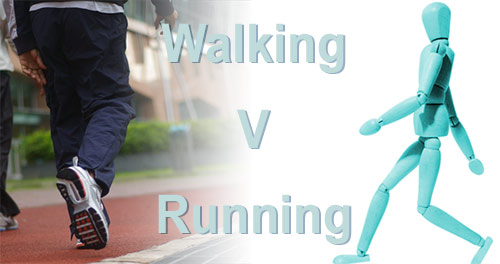Walking Vs Running
 Walking can often be overlooked as a way to build fitness levels and maintain good health but in fact, results have recently shown that the benefits of walking and running are much the same. Test results from studies carried out in California on 33,000 runners in the National Runners’ Health Study and 15,000 walkers in the National Walkers’ Health Study were compared and the results proved to be similar for both groups. Both the walkers and the runners had the same reductions in the risk of high blood pressure, diabetes and high cholesterol.
Walking can often be overlooked as a way to build fitness levels and maintain good health but in fact, results have recently shown that the benefits of walking and running are much the same. Test results from studies carried out in California on 33,000 runners in the National Runners’ Health Study and 15,000 walkers in the National Walkers’ Health Study were compared and the results proved to be similar for both groups. Both the walkers and the runners had the same reductions in the risk of high blood pressure, diabetes and high cholesterol.
The benefits of walking don’t end there; when done on a regular basis, walking can build muscle mass, increase bone strength, improve cardiovascular fitness and help maintain a healthy body weight. The fact that walking is lower impact than running also means that it is kinder to your joints, there is less risk of injury and it’s also safe to do during pregnancy. Studies have shown that being active has positive effects on brain function and regular exercise can reduce the risk of dementia by 40%, it can also reduce the risk of colon, breast and womb cancer by 20%.
Regular moderate intensity exercise, such as walking, has been proven to be just as effective as anti-depressants in cases of mild to moderate depression. The release of feel-good endorphins into the bloodstream reduces stress and anxiety, leaving us feeling great after being active. It can be hard to believe, but the more active we are the more energy we have, and a brisk walk on the treadmill is one of the best energy boosters there is, leaving you ready to tackle the rest of your gym workout with ease.
The great thing about walking on the treadmill is that you can vary the intensity and speed of your walking. But first things first, check your posture and alignment as they are key to walking comfortably and easily. Make sure to stand tall, draw your tummy in slightly to activate your core muscles and keep your shoulders back. Then check how you walk, the walking step is a rolling motion; striking the ground first with your heel and then rolling through to the toes. Remember to avoid taking too big of a stride, taking smaller steps instead of long strides is better for preventing injuries, stretching the quads, hamstrings and hips before you walk will also help. Start out at an easy pace to warm up for five minutes before you increase your pace or add hills.
It’s good if you can make it a habit to walk five days a week. If you are new to walking, a fifteen minute walk can be a good way to start. Take your time week by week to build your fitness levels and increase the time by five minutes each week until you can comfortably walk for half an hour or more. You can add inclines and increase and alternate speed as you get more comfortable. You should aim to be walking at a pace where you are breathing noticeably but can still have a conversation, walking at this speed will improve heart health and burn fat.
While walking is great for your lower body, toning your legs and firming your bum, it can be easy to forget about the arms. To tone the upper body as you walk try using hand weights or simply bend the arms at the elbow and swing them back and forth as you walk. The faster you swing them, the faster you walk and all this movement helps to tone the arms, upper back and shoulders, making it more of a whole body workout.
So what are you waiting for? Vigorous exercise isn’t the only way to get fit and healthy. Get on the treadmill (or on the pavement) and take the steps towards a fitter, healthier you!
Author:
Fiona McBennett

